Marketing in Hospitality: Strategies for Four Seasons Hotels Report
VerifiedAdded on 2020/04/21
|14
|4468
|79
Report
AI Summary
This report provides a comprehensive analysis of marketing strategies within the hospitality industry, using Four Seasons Hotels and Resorts as a case study. The report begins with an introduction to marketing concepts, the marketing process, and the impact of micro and macro environmental factors. It examines the relevance of the consumer market, the rationale for market segmentation, and the importance of the marketing mix components, including product, price, place, and promotion. Pricing strategies and policies employed by Four Seasons are discussed, followed by an exploration of the promotional mix, advertising campaigns, sales promotion, and public relations. The report also addresses the relevance of marketing research, different media for marketing, and the evaluation of marketing plan implementation. The report highlights the importance of customer satisfaction, loyalty, and the strategic use of various marketing tools to achieve organizational objectives within the competitive hospitality sector. The report is contributed by a student and is published on the website Desklib, a platform that provides all the necessary AI-based study tools for students.
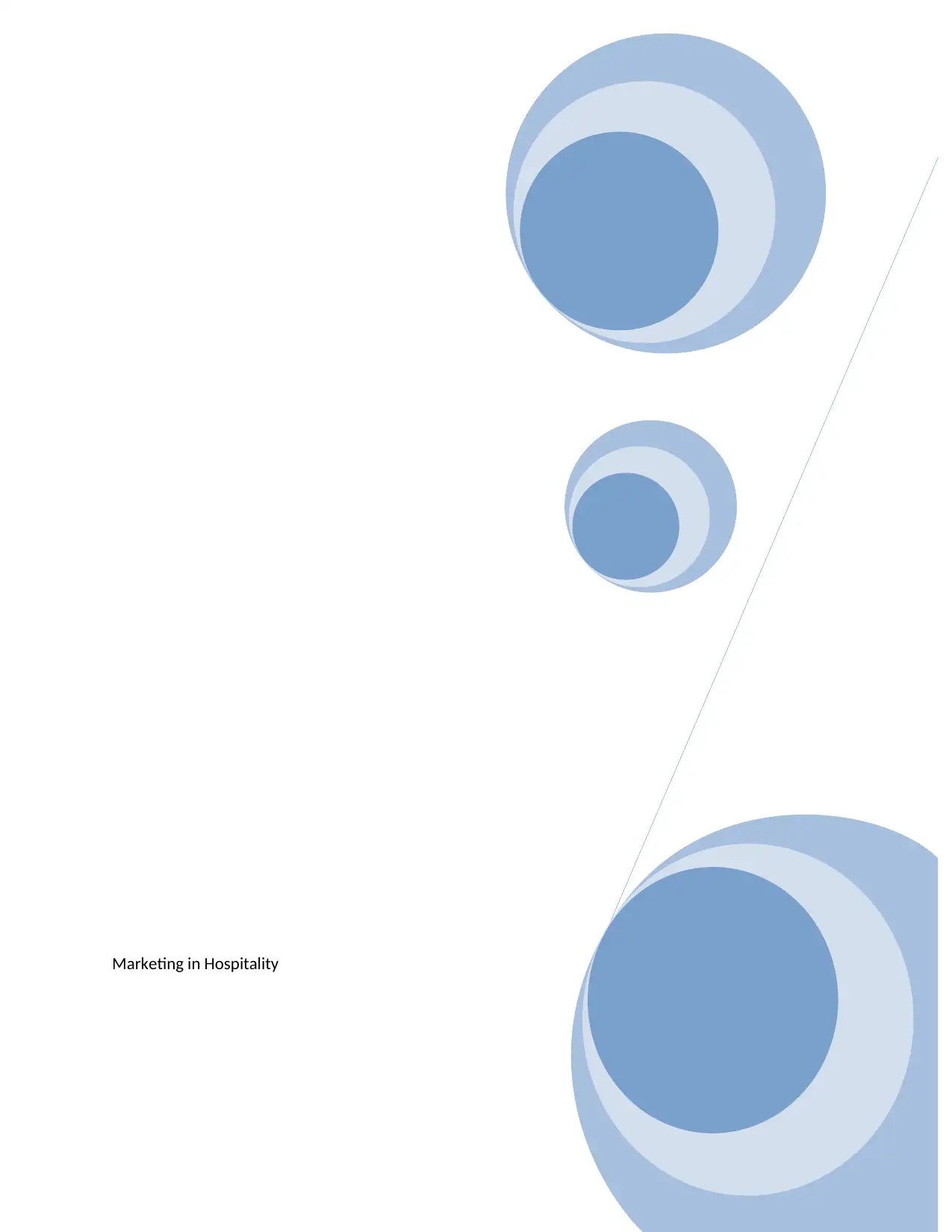
Marketing in Hospitality
Paraphrase This Document
Need a fresh take? Get an instant paraphrase of this document with our AI Paraphraser
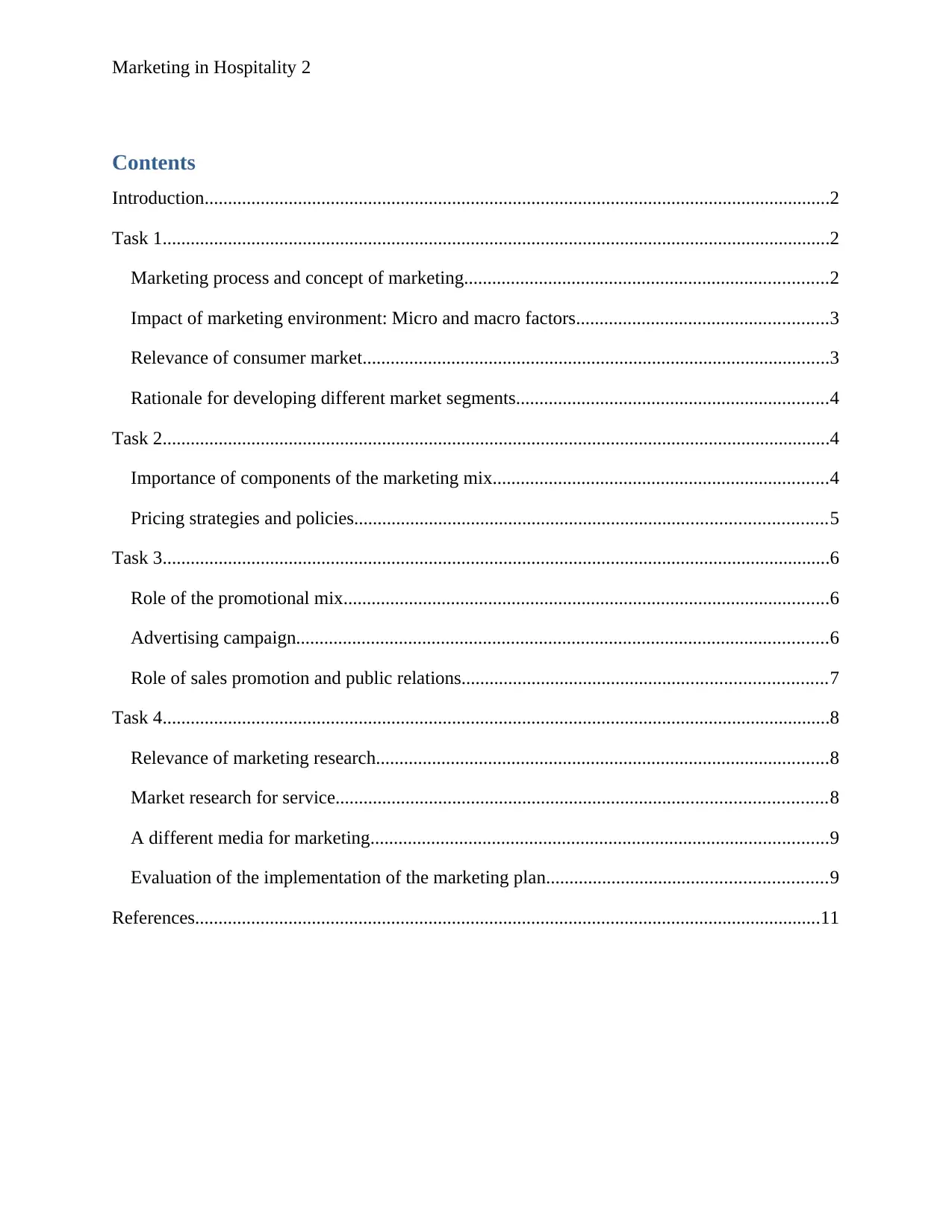
Marketing in Hospitality 2
Contents
Introduction......................................................................................................................................2
Task 1...............................................................................................................................................2
Marketing process and concept of marketing..............................................................................2
Impact of marketing environment: Micro and macro factors......................................................3
Relevance of consumer market....................................................................................................3
Rationale for developing different market segments...................................................................4
Task 2...............................................................................................................................................4
Importance of components of the marketing mix........................................................................4
Pricing strategies and policies.....................................................................................................5
Task 3...............................................................................................................................................6
Role of the promotional mix........................................................................................................6
Advertising campaign..................................................................................................................6
Role of sales promotion and public relations..............................................................................7
Task 4...............................................................................................................................................8
Relevance of marketing research.................................................................................................8
Market research for service.........................................................................................................8
A different media for marketing..................................................................................................9
Evaluation of the implementation of the marketing plan............................................................9
References......................................................................................................................................11
Contents
Introduction......................................................................................................................................2
Task 1...............................................................................................................................................2
Marketing process and concept of marketing..............................................................................2
Impact of marketing environment: Micro and macro factors......................................................3
Relevance of consumer market....................................................................................................3
Rationale for developing different market segments...................................................................4
Task 2...............................................................................................................................................4
Importance of components of the marketing mix........................................................................4
Pricing strategies and policies.....................................................................................................5
Task 3...............................................................................................................................................6
Role of the promotional mix........................................................................................................6
Advertising campaign..................................................................................................................6
Role of sales promotion and public relations..............................................................................7
Task 4...............................................................................................................................................8
Relevance of marketing research.................................................................................................8
Market research for service.........................................................................................................8
A different media for marketing..................................................................................................9
Evaluation of the implementation of the marketing plan............................................................9
References......................................................................................................................................11
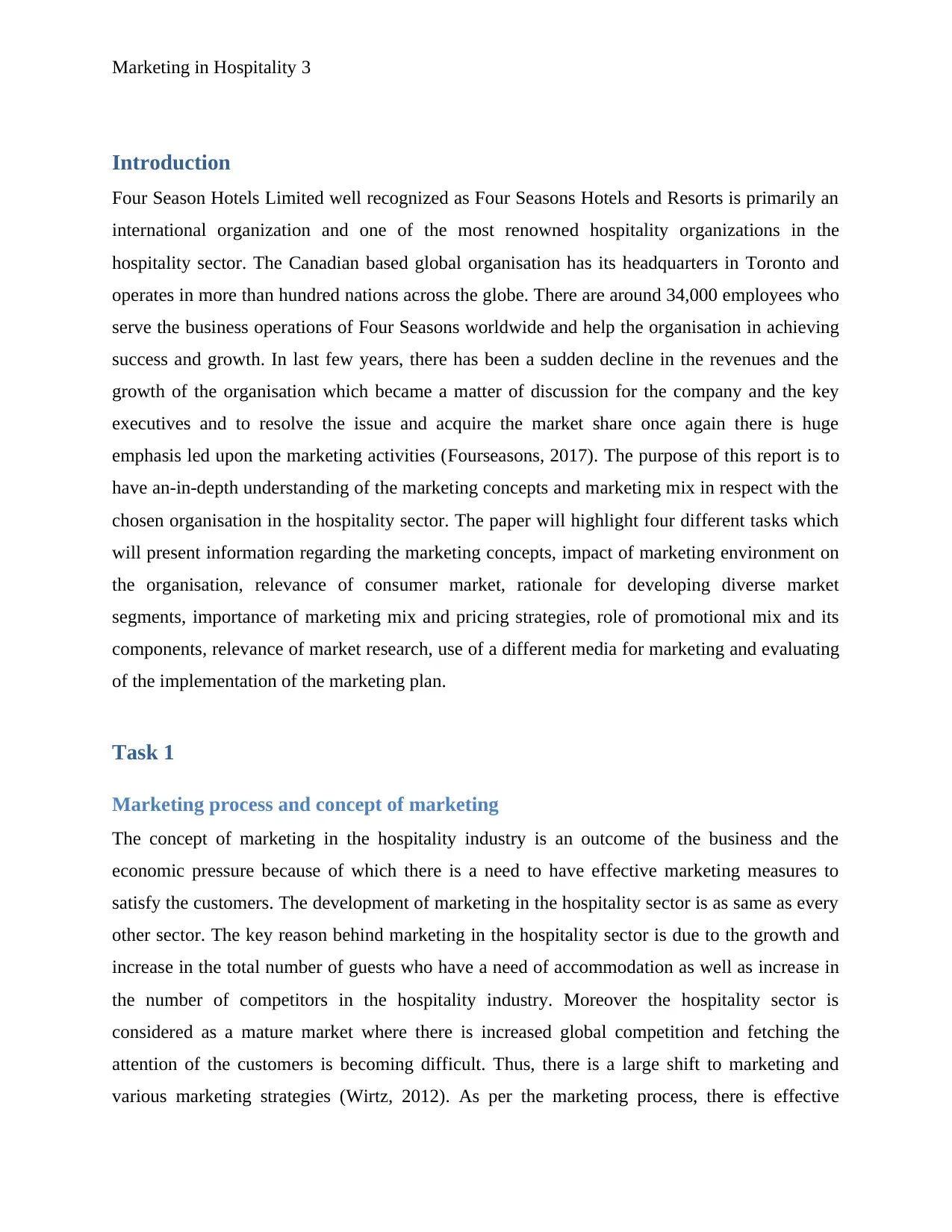
Marketing in Hospitality 3
Introduction
Four Season Hotels Limited well recognized as Four Seasons Hotels and Resorts is primarily an
international organization and one of the most renowned hospitality organizations in the
hospitality sector. The Canadian based global organisation has its headquarters in Toronto and
operates in more than hundred nations across the globe. There are around 34,000 employees who
serve the business operations of Four Seasons worldwide and help the organisation in achieving
success and growth. In last few years, there has been a sudden decline in the revenues and the
growth of the organisation which became a matter of discussion for the company and the key
executives and to resolve the issue and acquire the market share once again there is huge
emphasis led upon the marketing activities (Fourseasons, 2017). The purpose of this report is to
have an-in-depth understanding of the marketing concepts and marketing mix in respect with the
chosen organisation in the hospitality sector. The paper will highlight four different tasks which
will present information regarding the marketing concepts, impact of marketing environment on
the organisation, relevance of consumer market, rationale for developing diverse market
segments, importance of marketing mix and pricing strategies, role of promotional mix and its
components, relevance of market research, use of a different media for marketing and evaluating
of the implementation of the marketing plan.
Task 1
Marketing process and concept of marketing
The concept of marketing in the hospitality industry is an outcome of the business and the
economic pressure because of which there is a need to have effective marketing measures to
satisfy the customers. The development of marketing in the hospitality sector is as same as every
other sector. The key reason behind marketing in the hospitality sector is due to the growth and
increase in the total number of guests who have a need of accommodation as well as increase in
the number of competitors in the hospitality industry. Moreover the hospitality sector is
considered as a mature market where there is increased global competition and fetching the
attention of the customers is becoming difficult. Thus, there is a large shift to marketing and
various marketing strategies (Wirtz, 2012). As per the marketing process, there is effective
Introduction
Four Season Hotels Limited well recognized as Four Seasons Hotels and Resorts is primarily an
international organization and one of the most renowned hospitality organizations in the
hospitality sector. The Canadian based global organisation has its headquarters in Toronto and
operates in more than hundred nations across the globe. There are around 34,000 employees who
serve the business operations of Four Seasons worldwide and help the organisation in achieving
success and growth. In last few years, there has been a sudden decline in the revenues and the
growth of the organisation which became a matter of discussion for the company and the key
executives and to resolve the issue and acquire the market share once again there is huge
emphasis led upon the marketing activities (Fourseasons, 2017). The purpose of this report is to
have an-in-depth understanding of the marketing concepts and marketing mix in respect with the
chosen organisation in the hospitality sector. The paper will highlight four different tasks which
will present information regarding the marketing concepts, impact of marketing environment on
the organisation, relevance of consumer market, rationale for developing diverse market
segments, importance of marketing mix and pricing strategies, role of promotional mix and its
components, relevance of market research, use of a different media for marketing and evaluating
of the implementation of the marketing plan.
Task 1
Marketing process and concept of marketing
The concept of marketing in the hospitality industry is an outcome of the business and the
economic pressure because of which there is a need to have effective marketing measures to
satisfy the customers. The development of marketing in the hospitality sector is as same as every
other sector. The key reason behind marketing in the hospitality sector is due to the growth and
increase in the total number of guests who have a need of accommodation as well as increase in
the number of competitors in the hospitality industry. Moreover the hospitality sector is
considered as a mature market where there is increased global competition and fetching the
attention of the customers is becoming difficult. Thus, there is a large shift to marketing and
various marketing strategies (Wirtz, 2012). As per the marketing process, there is effective
⊘ This is a preview!⊘
Do you want full access?
Subscribe today to unlock all pages.

Trusted by 1+ million students worldwide
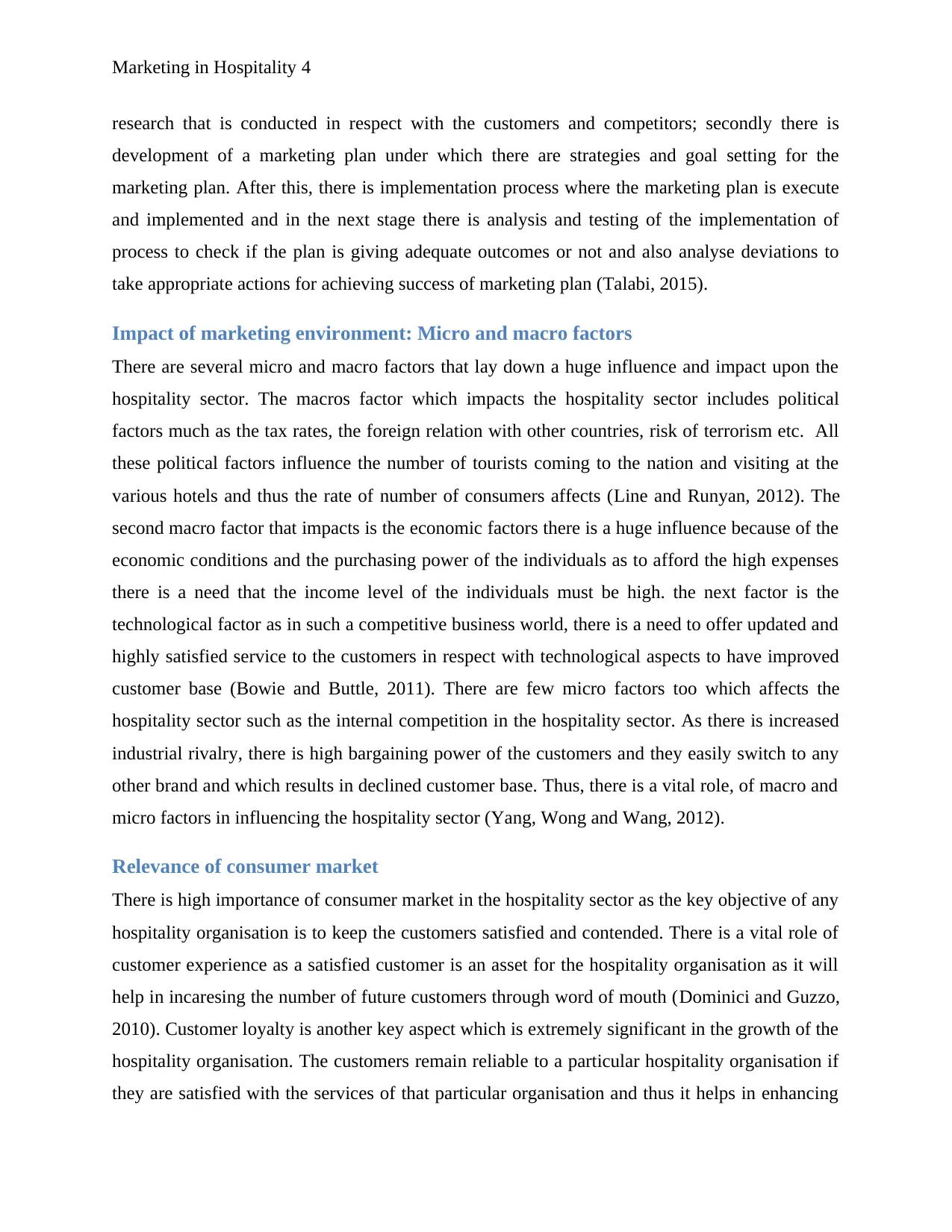
Marketing in Hospitality 4
research that is conducted in respect with the customers and competitors; secondly there is
development of a marketing plan under which there are strategies and goal setting for the
marketing plan. After this, there is implementation process where the marketing plan is execute
and implemented and in the next stage there is analysis and testing of the implementation of
process to check if the plan is giving adequate outcomes or not and also analyse deviations to
take appropriate actions for achieving success of marketing plan (Talabi, 2015).
Impact of marketing environment: Micro and macro factors
There are several micro and macro factors that lay down a huge influence and impact upon the
hospitality sector. The macros factor which impacts the hospitality sector includes political
factors much as the tax rates, the foreign relation with other countries, risk of terrorism etc. All
these political factors influence the number of tourists coming to the nation and visiting at the
various hotels and thus the rate of number of consumers affects (Line and Runyan, 2012). The
second macro factor that impacts is the economic factors there is a huge influence because of the
economic conditions and the purchasing power of the individuals as to afford the high expenses
there is a need that the income level of the individuals must be high. the next factor is the
technological factor as in such a competitive business world, there is a need to offer updated and
highly satisfied service to the customers in respect with technological aspects to have improved
customer base (Bowie and Buttle, 2011). There are few micro factors too which affects the
hospitality sector such as the internal competition in the hospitality sector. As there is increased
industrial rivalry, there is high bargaining power of the customers and they easily switch to any
other brand and which results in declined customer base. Thus, there is a vital role, of macro and
micro factors in influencing the hospitality sector (Yang, Wong and Wang, 2012).
Relevance of consumer market
There is high importance of consumer market in the hospitality sector as the key objective of any
hospitality organisation is to keep the customers satisfied and contended. There is a vital role of
customer experience as a satisfied customer is an asset for the hospitality organisation as it will
help in incaresing the number of future customers through word of mouth (Dominici and Guzzo,
2010). Customer loyalty is another key aspect which is extremely significant in the growth of the
hospitality organisation. The customers remain reliable to a particular hospitality organisation if
they are satisfied with the services of that particular organisation and thus it helps in enhancing
research that is conducted in respect with the customers and competitors; secondly there is
development of a marketing plan under which there are strategies and goal setting for the
marketing plan. After this, there is implementation process where the marketing plan is execute
and implemented and in the next stage there is analysis and testing of the implementation of
process to check if the plan is giving adequate outcomes or not and also analyse deviations to
take appropriate actions for achieving success of marketing plan (Talabi, 2015).
Impact of marketing environment: Micro and macro factors
There are several micro and macro factors that lay down a huge influence and impact upon the
hospitality sector. The macros factor which impacts the hospitality sector includes political
factors much as the tax rates, the foreign relation with other countries, risk of terrorism etc. All
these political factors influence the number of tourists coming to the nation and visiting at the
various hotels and thus the rate of number of consumers affects (Line and Runyan, 2012). The
second macro factor that impacts is the economic factors there is a huge influence because of the
economic conditions and the purchasing power of the individuals as to afford the high expenses
there is a need that the income level of the individuals must be high. the next factor is the
technological factor as in such a competitive business world, there is a need to offer updated and
highly satisfied service to the customers in respect with technological aspects to have improved
customer base (Bowie and Buttle, 2011). There are few micro factors too which affects the
hospitality sector such as the internal competition in the hospitality sector. As there is increased
industrial rivalry, there is high bargaining power of the customers and they easily switch to any
other brand and which results in declined customer base. Thus, there is a vital role, of macro and
micro factors in influencing the hospitality sector (Yang, Wong and Wang, 2012).
Relevance of consumer market
There is high importance of consumer market in the hospitality sector as the key objective of any
hospitality organisation is to keep the customers satisfied and contended. There is a vital role of
customer experience as a satisfied customer is an asset for the hospitality organisation as it will
help in incaresing the number of future customers through word of mouth (Dominici and Guzzo,
2010). Customer loyalty is another key aspect which is extremely significant in the growth of the
hospitality organisation. The customers remain reliable to a particular hospitality organisation if
they are satisfied with the services of that particular organisation and thus it helps in enhancing
Paraphrase This Document
Need a fresh take? Get an instant paraphrase of this document with our AI Paraphraser
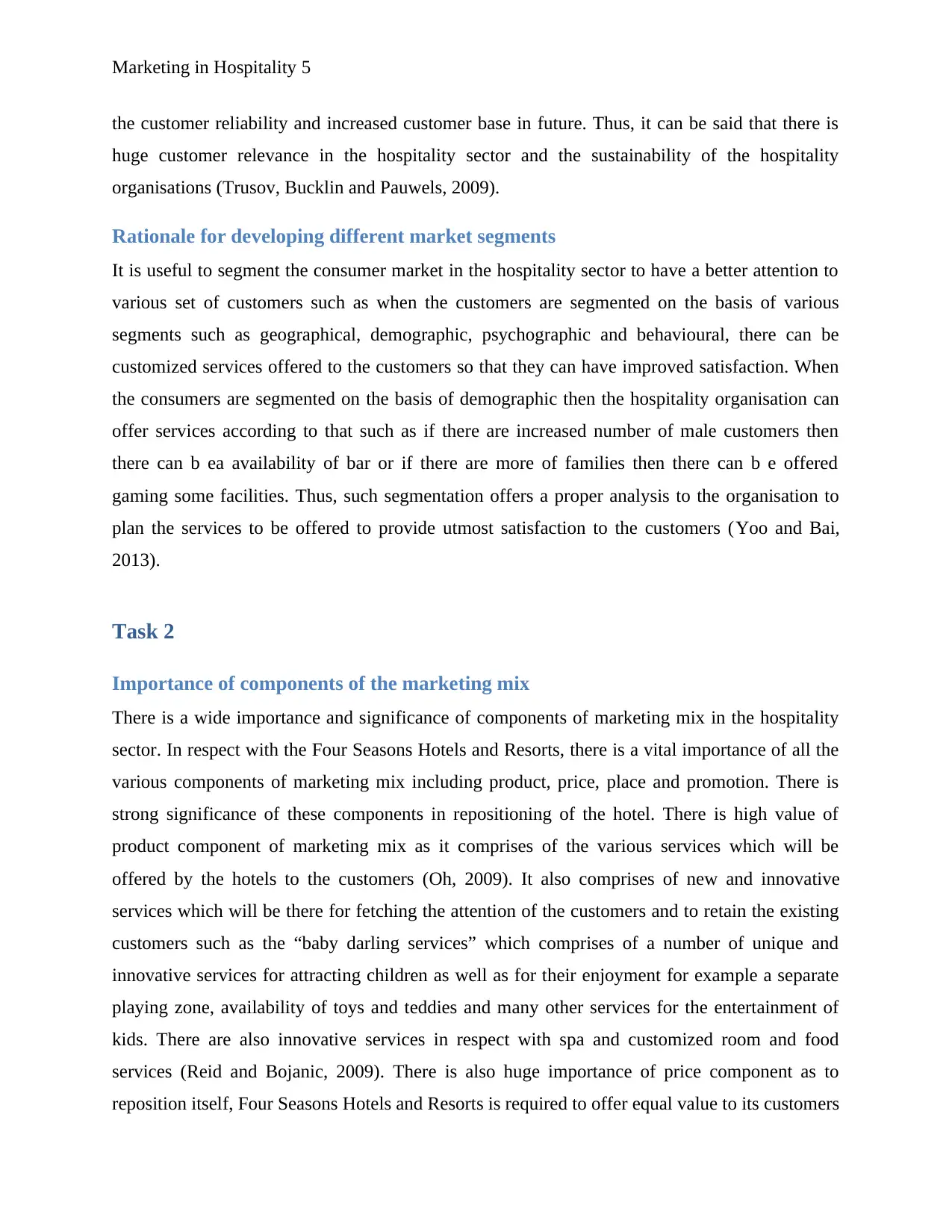
Marketing in Hospitality 5
the customer reliability and increased customer base in future. Thus, it can be said that there is
huge customer relevance in the hospitality sector and the sustainability of the hospitality
organisations (Trusov, Bucklin and Pauwels, 2009).
Rationale for developing different market segments
It is useful to segment the consumer market in the hospitality sector to have a better attention to
various set of customers such as when the customers are segmented on the basis of various
segments such as geographical, demographic, psychographic and behavioural, there can be
customized services offered to the customers so that they can have improved satisfaction. When
the consumers are segmented on the basis of demographic then the hospitality organisation can
offer services according to that such as if there are increased number of male customers then
there can b ea availability of bar or if there are more of families then there can b e offered
gaming some facilities. Thus, such segmentation offers a proper analysis to the organisation to
plan the services to be offered to provide utmost satisfaction to the customers (Yoo and Bai,
2013).
Task 2
Importance of components of the marketing mix
There is a wide importance and significance of components of marketing mix in the hospitality
sector. In respect with the Four Seasons Hotels and Resorts, there is a vital importance of all the
various components of marketing mix including product, price, place and promotion. There is
strong significance of these components in repositioning of the hotel. There is high value of
product component of marketing mix as it comprises of the various services which will be
offered by the hotels to the customers (Oh, 2009). It also comprises of new and innovative
services which will be there for fetching the attention of the customers and to retain the existing
customers such as the “baby darling services” which comprises of a number of unique and
innovative services for attracting children as well as for their enjoyment for example a separate
playing zone, availability of toys and teddies and many other services for the entertainment of
kids. There are also innovative services in respect with spa and customized room and food
services (Reid and Bojanic, 2009). There is also huge importance of price component as to
reposition itself, Four Seasons Hotels and Resorts is required to offer equal value to its customers
the customer reliability and increased customer base in future. Thus, it can be said that there is
huge customer relevance in the hospitality sector and the sustainability of the hospitality
organisations (Trusov, Bucklin and Pauwels, 2009).
Rationale for developing different market segments
It is useful to segment the consumer market in the hospitality sector to have a better attention to
various set of customers such as when the customers are segmented on the basis of various
segments such as geographical, demographic, psychographic and behavioural, there can be
customized services offered to the customers so that they can have improved satisfaction. When
the consumers are segmented on the basis of demographic then the hospitality organisation can
offer services according to that such as if there are increased number of male customers then
there can b ea availability of bar or if there are more of families then there can b e offered
gaming some facilities. Thus, such segmentation offers a proper analysis to the organisation to
plan the services to be offered to provide utmost satisfaction to the customers (Yoo and Bai,
2013).
Task 2
Importance of components of the marketing mix
There is a wide importance and significance of components of marketing mix in the hospitality
sector. In respect with the Four Seasons Hotels and Resorts, there is a vital importance of all the
various components of marketing mix including product, price, place and promotion. There is
strong significance of these components in repositioning of the hotel. There is high value of
product component of marketing mix as it comprises of the various services which will be
offered by the hotels to the customers (Oh, 2009). It also comprises of new and innovative
services which will be there for fetching the attention of the customers and to retain the existing
customers such as the “baby darling services” which comprises of a number of unique and
innovative services for attracting children as well as for their enjoyment for example a separate
playing zone, availability of toys and teddies and many other services for the entertainment of
kids. There are also innovative services in respect with spa and customized room and food
services (Reid and Bojanic, 2009). There is also huge importance of price component as to
reposition itself, Four Seasons Hotels and Resorts is required to offer equal value to its customers
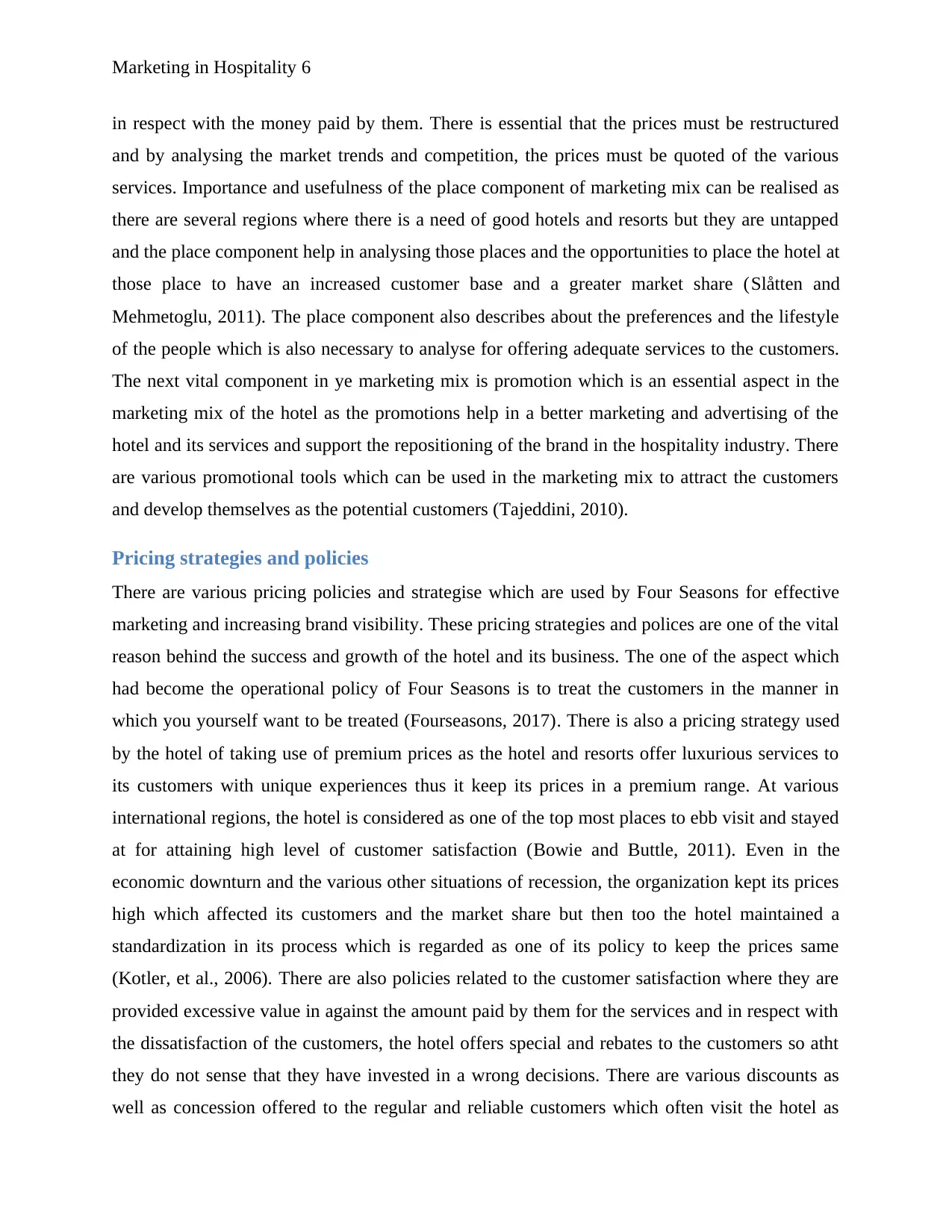
Marketing in Hospitality 6
in respect with the money paid by them. There is essential that the prices must be restructured
and by analysing the market trends and competition, the prices must be quoted of the various
services. Importance and usefulness of the place component of marketing mix can be realised as
there are several regions where there is a need of good hotels and resorts but they are untapped
and the place component help in analysing those places and the opportunities to place the hotel at
those place to have an increased customer base and a greater market share (Slåtten and
Mehmetoglu, 2011). The place component also describes about the preferences and the lifestyle
of the people which is also necessary to analyse for offering adequate services to the customers.
The next vital component in ye marketing mix is promotion which is an essential aspect in the
marketing mix of the hotel as the promotions help in a better marketing and advertising of the
hotel and its services and support the repositioning of the brand in the hospitality industry. There
are various promotional tools which can be used in the marketing mix to attract the customers
and develop themselves as the potential customers (Tajeddini, 2010).
Pricing strategies and policies
There are various pricing policies and strategise which are used by Four Seasons for effective
marketing and increasing brand visibility. These pricing strategies and polices are one of the vital
reason behind the success and growth of the hotel and its business. The one of the aspect which
had become the operational policy of Four Seasons is to treat the customers in the manner in
which you yourself want to be treated (Fourseasons, 2017). There is also a pricing strategy used
by the hotel of taking use of premium prices as the hotel and resorts offer luxurious services to
its customers with unique experiences thus it keep its prices in a premium range. At various
international regions, the hotel is considered as one of the top most places to ebb visit and stayed
at for attaining high level of customer satisfaction (Bowie and Buttle, 2011). Even in the
economic downturn and the various other situations of recession, the organization kept its prices
high which affected its customers and the market share but then too the hotel maintained a
standardization in its process which is regarded as one of its policy to keep the prices same
(Kotler, et al., 2006). There are also policies related to the customer satisfaction where they are
provided excessive value in against the amount paid by them for the services and in respect with
the dissatisfaction of the customers, the hotel offers special and rebates to the customers so atht
they do not sense that they have invested in a wrong decisions. There are various discounts as
well as concession offered to the regular and reliable customers which often visit the hotel as
in respect with the money paid by them. There is essential that the prices must be restructured
and by analysing the market trends and competition, the prices must be quoted of the various
services. Importance and usefulness of the place component of marketing mix can be realised as
there are several regions where there is a need of good hotels and resorts but they are untapped
and the place component help in analysing those places and the opportunities to place the hotel at
those place to have an increased customer base and a greater market share (Slåtten and
Mehmetoglu, 2011). The place component also describes about the preferences and the lifestyle
of the people which is also necessary to analyse for offering adequate services to the customers.
The next vital component in ye marketing mix is promotion which is an essential aspect in the
marketing mix of the hotel as the promotions help in a better marketing and advertising of the
hotel and its services and support the repositioning of the brand in the hospitality industry. There
are various promotional tools which can be used in the marketing mix to attract the customers
and develop themselves as the potential customers (Tajeddini, 2010).
Pricing strategies and policies
There are various pricing policies and strategise which are used by Four Seasons for effective
marketing and increasing brand visibility. These pricing strategies and polices are one of the vital
reason behind the success and growth of the hotel and its business. The one of the aspect which
had become the operational policy of Four Seasons is to treat the customers in the manner in
which you yourself want to be treated (Fourseasons, 2017). There is also a pricing strategy used
by the hotel of taking use of premium prices as the hotel and resorts offer luxurious services to
its customers with unique experiences thus it keep its prices in a premium range. At various
international regions, the hotel is considered as one of the top most places to ebb visit and stayed
at for attaining high level of customer satisfaction (Bowie and Buttle, 2011). Even in the
economic downturn and the various other situations of recession, the organization kept its prices
high which affected its customers and the market share but then too the hotel maintained a
standardization in its process which is regarded as one of its policy to keep the prices same
(Kotler, et al., 2006). There are also policies related to the customer satisfaction where they are
provided excessive value in against the amount paid by them for the services and in respect with
the dissatisfaction of the customers, the hotel offers special and rebates to the customers so atht
they do not sense that they have invested in a wrong decisions. There are various discounts as
well as concession offered to the regular and reliable customers which often visit the hotel as
⊘ This is a preview!⊘
Do you want full access?
Subscribe today to unlock all pages.

Trusted by 1+ million students worldwide
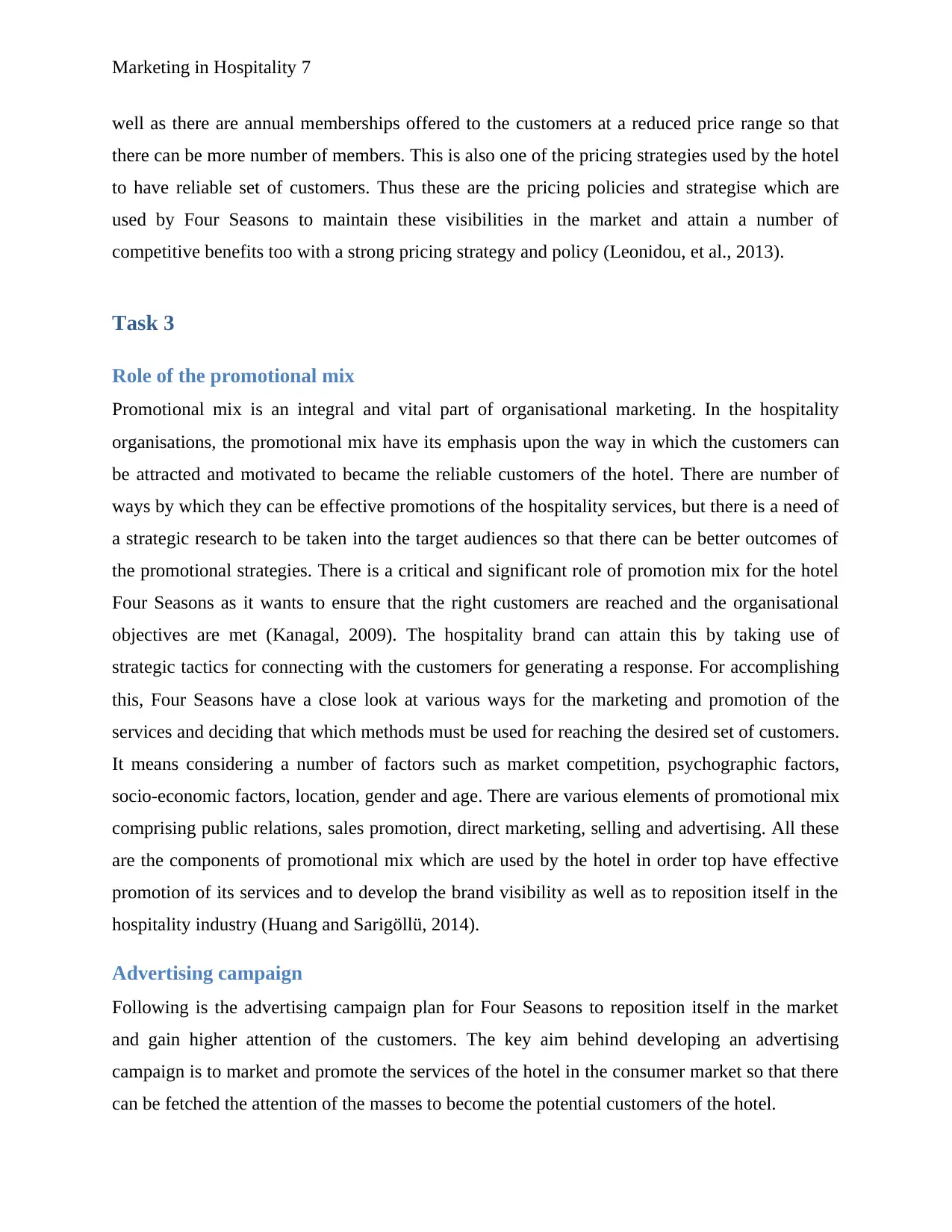
Marketing in Hospitality 7
well as there are annual memberships offered to the customers at a reduced price range so that
there can be more number of members. This is also one of the pricing strategies used by the hotel
to have reliable set of customers. Thus these are the pricing policies and strategise which are
used by Four Seasons to maintain these visibilities in the market and attain a number of
competitive benefits too with a strong pricing strategy and policy (Leonidou, et al., 2013).
Task 3
Role of the promotional mix
Promotional mix is an integral and vital part of organisational marketing. In the hospitality
organisations, the promotional mix have its emphasis upon the way in which the customers can
be attracted and motivated to became the reliable customers of the hotel. There are number of
ways by which they can be effective promotions of the hospitality services, but there is a need of
a strategic research to be taken into the target audiences so that there can be better outcomes of
the promotional strategies. There is a critical and significant role of promotion mix for the hotel
Four Seasons as it wants to ensure that the right customers are reached and the organisational
objectives are met (Kanagal, 2009). The hospitality brand can attain this by taking use of
strategic tactics for connecting with the customers for generating a response. For accomplishing
this, Four Seasons have a close look at various ways for the marketing and promotion of the
services and deciding that which methods must be used for reaching the desired set of customers.
It means considering a number of factors such as market competition, psychographic factors,
socio-economic factors, location, gender and age. There are various elements of promotional mix
comprising public relations, sales promotion, direct marketing, selling and advertising. All these
are the components of promotional mix which are used by the hotel in order top have effective
promotion of its services and to develop the brand visibility as well as to reposition itself in the
hospitality industry (Huang and Sarigöllü, 2014).
Advertising campaign
Following is the advertising campaign plan for Four Seasons to reposition itself in the market
and gain higher attention of the customers. The key aim behind developing an advertising
campaign is to market and promote the services of the hotel in the consumer market so that there
can be fetched the attention of the masses to become the potential customers of the hotel.
well as there are annual memberships offered to the customers at a reduced price range so that
there can be more number of members. This is also one of the pricing strategies used by the hotel
to have reliable set of customers. Thus these are the pricing policies and strategise which are
used by Four Seasons to maintain these visibilities in the market and attain a number of
competitive benefits too with a strong pricing strategy and policy (Leonidou, et al., 2013).
Task 3
Role of the promotional mix
Promotional mix is an integral and vital part of organisational marketing. In the hospitality
organisations, the promotional mix have its emphasis upon the way in which the customers can
be attracted and motivated to became the reliable customers of the hotel. There are number of
ways by which they can be effective promotions of the hospitality services, but there is a need of
a strategic research to be taken into the target audiences so that there can be better outcomes of
the promotional strategies. There is a critical and significant role of promotion mix for the hotel
Four Seasons as it wants to ensure that the right customers are reached and the organisational
objectives are met (Kanagal, 2009). The hospitality brand can attain this by taking use of
strategic tactics for connecting with the customers for generating a response. For accomplishing
this, Four Seasons have a close look at various ways for the marketing and promotion of the
services and deciding that which methods must be used for reaching the desired set of customers.
It means considering a number of factors such as market competition, psychographic factors,
socio-economic factors, location, gender and age. There are various elements of promotional mix
comprising public relations, sales promotion, direct marketing, selling and advertising. All these
are the components of promotional mix which are used by the hotel in order top have effective
promotion of its services and to develop the brand visibility as well as to reposition itself in the
hospitality industry (Huang and Sarigöllü, 2014).
Advertising campaign
Following is the advertising campaign plan for Four Seasons to reposition itself in the market
and gain higher attention of the customers. The key aim behind developing an advertising
campaign is to market and promote the services of the hotel in the consumer market so that there
can be fetched the attention of the masses to become the potential customers of the hotel.
Paraphrase This Document
Need a fresh take? Get an instant paraphrase of this document with our AI Paraphraser
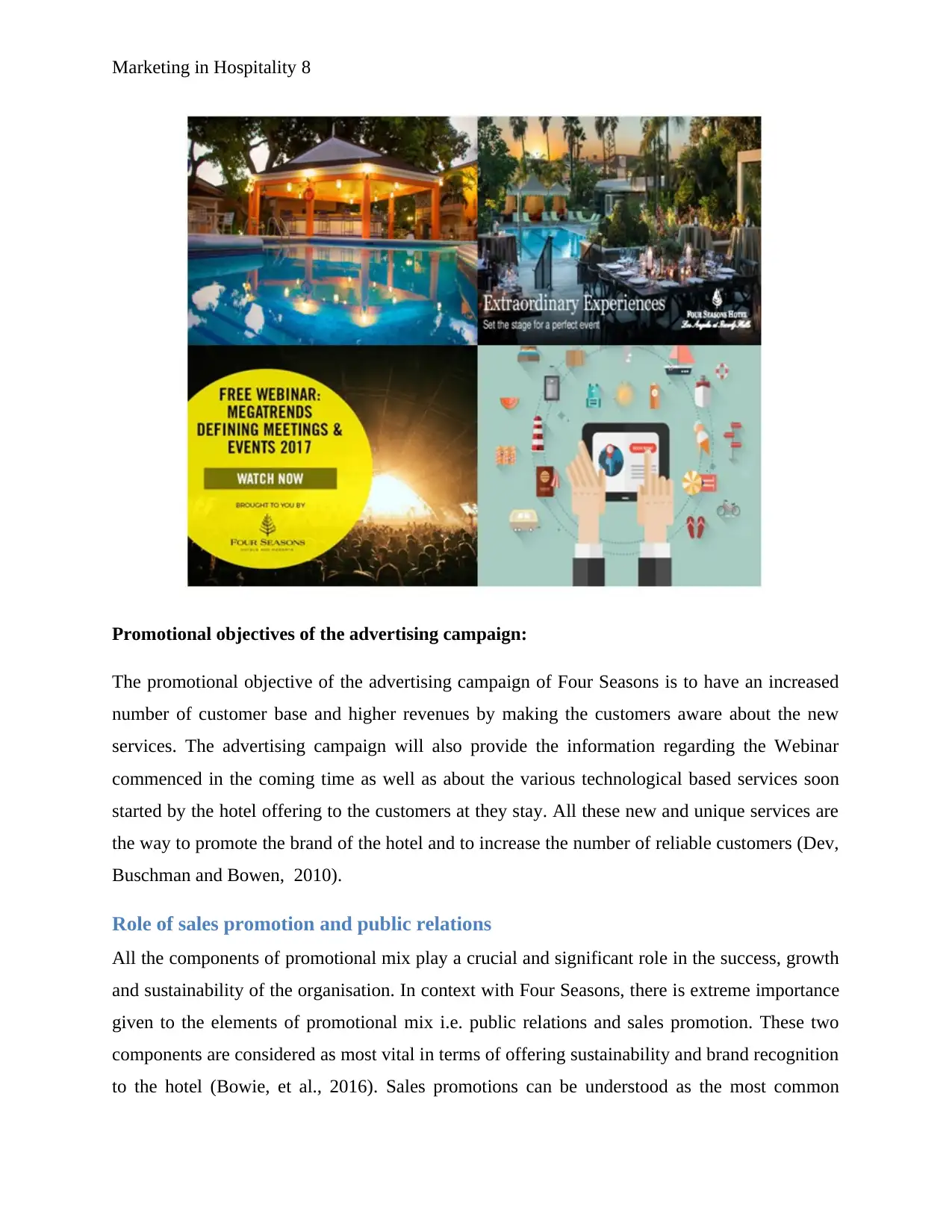
Marketing in Hospitality 8
Promotional objectives of the advertising campaign:
The promotional objective of the advertising campaign of Four Seasons is to have an increased
number of customer base and higher revenues by making the customers aware about the new
services. The advertising campaign will also provide the information regarding the Webinar
commenced in the coming time as well as about the various technological based services soon
started by the hotel offering to the customers at they stay. All these new and unique services are
the way to promote the brand of the hotel and to increase the number of reliable customers (Dev,
Buschman and Bowen, 2010).
Role of sales promotion and public relations
All the components of promotional mix play a crucial and significant role in the success, growth
and sustainability of the organisation. In context with Four Seasons, there is extreme importance
given to the elements of promotional mix i.e. public relations and sales promotion. These two
components are considered as most vital in terms of offering sustainability and brand recognition
to the hotel (Bowie, et al., 2016). Sales promotions can be understood as the most common
Promotional objectives of the advertising campaign:
The promotional objective of the advertising campaign of Four Seasons is to have an increased
number of customer base and higher revenues by making the customers aware about the new
services. The advertising campaign will also provide the information regarding the Webinar
commenced in the coming time as well as about the various technological based services soon
started by the hotel offering to the customers at they stay. All these new and unique services are
the way to promote the brand of the hotel and to increase the number of reliable customers (Dev,
Buschman and Bowen, 2010).
Role of sales promotion and public relations
All the components of promotional mix play a crucial and significant role in the success, growth
and sustainability of the organisation. In context with Four Seasons, there is extreme importance
given to the elements of promotional mix i.e. public relations and sales promotion. These two
components are considered as most vital in terms of offering sustainability and brand recognition
to the hotel (Bowie, et al., 2016). Sales promotions can be understood as the most common
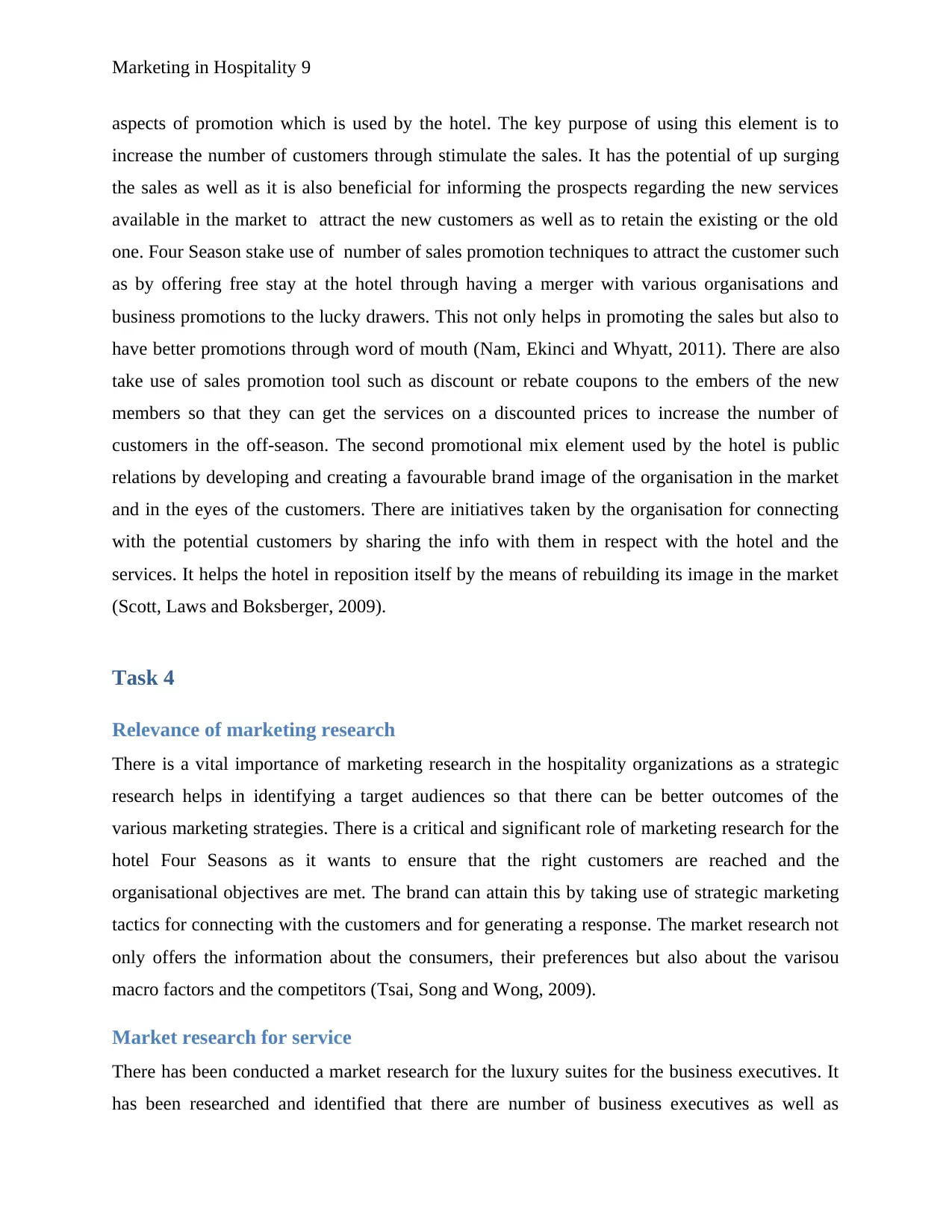
Marketing in Hospitality 9
aspects of promotion which is used by the hotel. The key purpose of using this element is to
increase the number of customers through stimulate the sales. It has the potential of up surging
the sales as well as it is also beneficial for informing the prospects regarding the new services
available in the market to attract the new customers as well as to retain the existing or the old
one. Four Season stake use of number of sales promotion techniques to attract the customer such
as by offering free stay at the hotel through having a merger with various organisations and
business promotions to the lucky drawers. This not only helps in promoting the sales but also to
have better promotions through word of mouth (Nam, Ekinci and Whyatt, 2011). There are also
take use of sales promotion tool such as discount or rebate coupons to the embers of the new
members so that they can get the services on a discounted prices to increase the number of
customers in the off-season. The second promotional mix element used by the hotel is public
relations by developing and creating a favourable brand image of the organisation in the market
and in the eyes of the customers. There are initiatives taken by the organisation for connecting
with the potential customers by sharing the info with them in respect with the hotel and the
services. It helps the hotel in reposition itself by the means of rebuilding its image in the market
(Scott, Laws and Boksberger, 2009).
Task 4
Relevance of marketing research
There is a vital importance of marketing research in the hospitality organizations as a strategic
research helps in identifying a target audiences so that there can be better outcomes of the
various marketing strategies. There is a critical and significant role of marketing research for the
hotel Four Seasons as it wants to ensure that the right customers are reached and the
organisational objectives are met. The brand can attain this by taking use of strategic marketing
tactics for connecting with the customers and for generating a response. The market research not
only offers the information about the consumers, their preferences but also about the varisou
macro factors and the competitors (Tsai, Song and Wong, 2009).
Market research for service
There has been conducted a market research for the luxury suites for the business executives. It
has been researched and identified that there are number of business executives as well as
aspects of promotion which is used by the hotel. The key purpose of using this element is to
increase the number of customers through stimulate the sales. It has the potential of up surging
the sales as well as it is also beneficial for informing the prospects regarding the new services
available in the market to attract the new customers as well as to retain the existing or the old
one. Four Season stake use of number of sales promotion techniques to attract the customer such
as by offering free stay at the hotel through having a merger with various organisations and
business promotions to the lucky drawers. This not only helps in promoting the sales but also to
have better promotions through word of mouth (Nam, Ekinci and Whyatt, 2011). There are also
take use of sales promotion tool such as discount or rebate coupons to the embers of the new
members so that they can get the services on a discounted prices to increase the number of
customers in the off-season. The second promotional mix element used by the hotel is public
relations by developing and creating a favourable brand image of the organisation in the market
and in the eyes of the customers. There are initiatives taken by the organisation for connecting
with the potential customers by sharing the info with them in respect with the hotel and the
services. It helps the hotel in reposition itself by the means of rebuilding its image in the market
(Scott, Laws and Boksberger, 2009).
Task 4
Relevance of marketing research
There is a vital importance of marketing research in the hospitality organizations as a strategic
research helps in identifying a target audiences so that there can be better outcomes of the
various marketing strategies. There is a critical and significant role of marketing research for the
hotel Four Seasons as it wants to ensure that the right customers are reached and the
organisational objectives are met. The brand can attain this by taking use of strategic marketing
tactics for connecting with the customers and for generating a response. The market research not
only offers the information about the consumers, their preferences but also about the varisou
macro factors and the competitors (Tsai, Song and Wong, 2009).
Market research for service
There has been conducted a market research for the luxury suites for the business executives. It
has been researched and identified that there are number of business executives as well as
⊘ This is a preview!⊘
Do you want full access?
Subscribe today to unlock all pages.

Trusted by 1+ million students worldwide
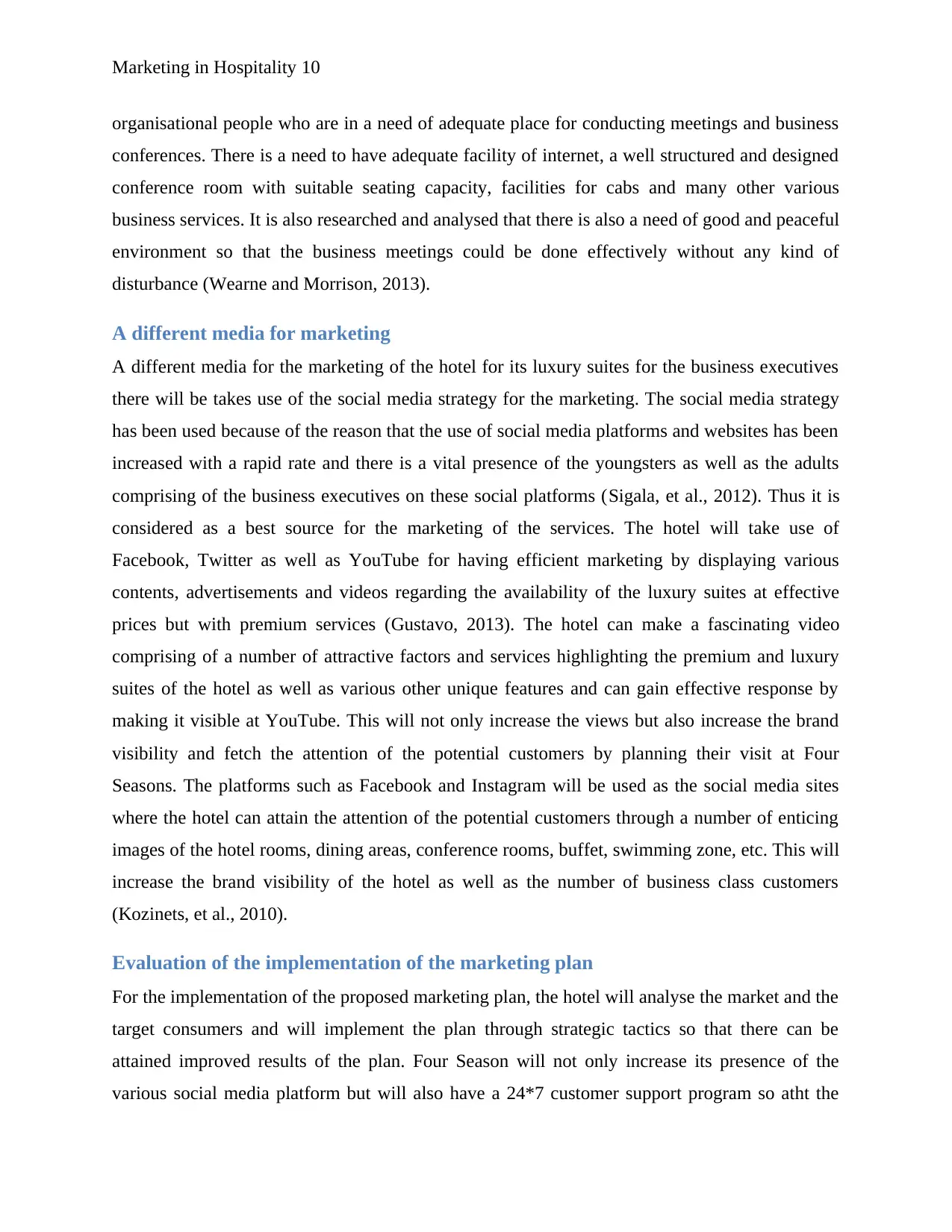
Marketing in Hospitality 10
organisational people who are in a need of adequate place for conducting meetings and business
conferences. There is a need to have adequate facility of internet, a well structured and designed
conference room with suitable seating capacity, facilities for cabs and many other various
business services. It is also researched and analysed that there is also a need of good and peaceful
environment so that the business meetings could be done effectively without any kind of
disturbance (Wearne and Morrison, 2013).
A different media for marketing
A different media for the marketing of the hotel for its luxury suites for the business executives
there will be takes use of the social media strategy for the marketing. The social media strategy
has been used because of the reason that the use of social media platforms and websites has been
increased with a rapid rate and there is a vital presence of the youngsters as well as the adults
comprising of the business executives on these social platforms (Sigala, et al., 2012). Thus it is
considered as a best source for the marketing of the services. The hotel will take use of
Facebook, Twitter as well as YouTube for having efficient marketing by displaying various
contents, advertisements and videos regarding the availability of the luxury suites at effective
prices but with premium services (Gustavo, 2013). The hotel can make a fascinating video
comprising of a number of attractive factors and services highlighting the premium and luxury
suites of the hotel as well as various other unique features and can gain effective response by
making it visible at YouTube. This will not only increase the views but also increase the brand
visibility and fetch the attention of the potential customers by planning their visit at Four
Seasons. The platforms such as Facebook and Instagram will be used as the social media sites
where the hotel can attain the attention of the potential customers through a number of enticing
images of the hotel rooms, dining areas, conference rooms, buffet, swimming zone, etc. This will
increase the brand visibility of the hotel as well as the number of business class customers
(Kozinets, et al., 2010).
Evaluation of the implementation of the marketing plan
For the implementation of the proposed marketing plan, the hotel will analyse the market and the
target consumers and will implement the plan through strategic tactics so that there can be
attained improved results of the plan. Four Season will not only increase its presence of the
various social media platform but will also have a 24*7 customer support program so atht the
organisational people who are in a need of adequate place for conducting meetings and business
conferences. There is a need to have adequate facility of internet, a well structured and designed
conference room with suitable seating capacity, facilities for cabs and many other various
business services. It is also researched and analysed that there is also a need of good and peaceful
environment so that the business meetings could be done effectively without any kind of
disturbance (Wearne and Morrison, 2013).
A different media for marketing
A different media for the marketing of the hotel for its luxury suites for the business executives
there will be takes use of the social media strategy for the marketing. The social media strategy
has been used because of the reason that the use of social media platforms and websites has been
increased with a rapid rate and there is a vital presence of the youngsters as well as the adults
comprising of the business executives on these social platforms (Sigala, et al., 2012). Thus it is
considered as a best source for the marketing of the services. The hotel will take use of
Facebook, Twitter as well as YouTube for having efficient marketing by displaying various
contents, advertisements and videos regarding the availability of the luxury suites at effective
prices but with premium services (Gustavo, 2013). The hotel can make a fascinating video
comprising of a number of attractive factors and services highlighting the premium and luxury
suites of the hotel as well as various other unique features and can gain effective response by
making it visible at YouTube. This will not only increase the views but also increase the brand
visibility and fetch the attention of the potential customers by planning their visit at Four
Seasons. The platforms such as Facebook and Instagram will be used as the social media sites
where the hotel can attain the attention of the potential customers through a number of enticing
images of the hotel rooms, dining areas, conference rooms, buffet, swimming zone, etc. This will
increase the brand visibility of the hotel as well as the number of business class customers
(Kozinets, et al., 2010).
Evaluation of the implementation of the marketing plan
For the implementation of the proposed marketing plan, the hotel will analyse the market and the
target consumers and will implement the plan through strategic tactics so that there can be
attained improved results of the plan. Four Season will not only increase its presence of the
various social media platform but will also have a 24*7 customer support program so atht the
Paraphrase This Document
Need a fresh take? Get an instant paraphrase of this document with our AI Paraphraser
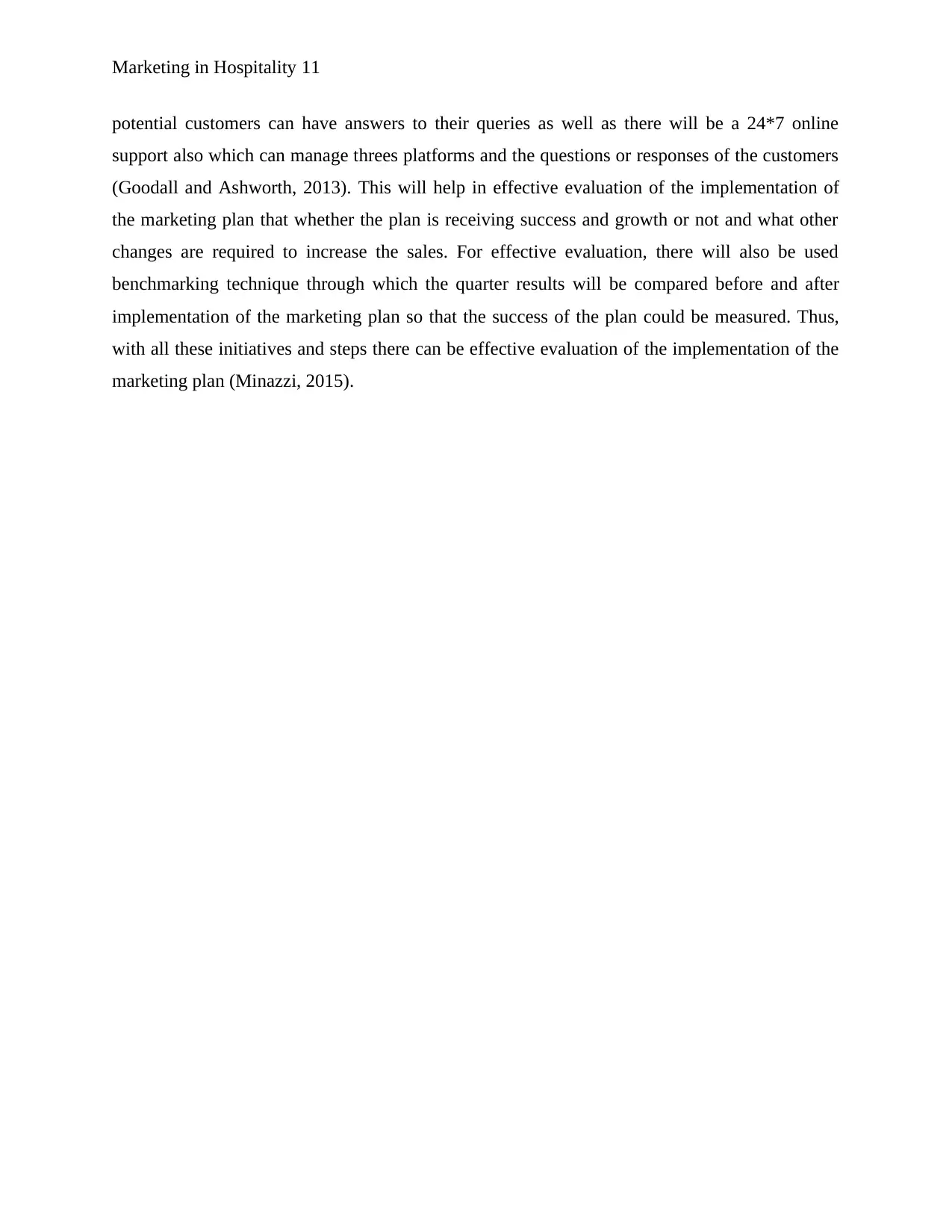
Marketing in Hospitality 11
potential customers can have answers to their queries as well as there will be a 24*7 online
support also which can manage threes platforms and the questions or responses of the customers
(Goodall and Ashworth, 2013). This will help in effective evaluation of the implementation of
the marketing plan that whether the plan is receiving success and growth or not and what other
changes are required to increase the sales. For effective evaluation, there will also be used
benchmarking technique through which the quarter results will be compared before and after
implementation of the marketing plan so that the success of the plan could be measured. Thus,
with all these initiatives and steps there can be effective evaluation of the implementation of the
marketing plan (Minazzi, 2015).
potential customers can have answers to their queries as well as there will be a 24*7 online
support also which can manage threes platforms and the questions or responses of the customers
(Goodall and Ashworth, 2013). This will help in effective evaluation of the implementation of
the marketing plan that whether the plan is receiving success and growth or not and what other
changes are required to increase the sales. For effective evaluation, there will also be used
benchmarking technique through which the quarter results will be compared before and after
implementation of the marketing plan so that the success of the plan could be measured. Thus,
with all these initiatives and steps there can be effective evaluation of the implementation of the
marketing plan (Minazzi, 2015).
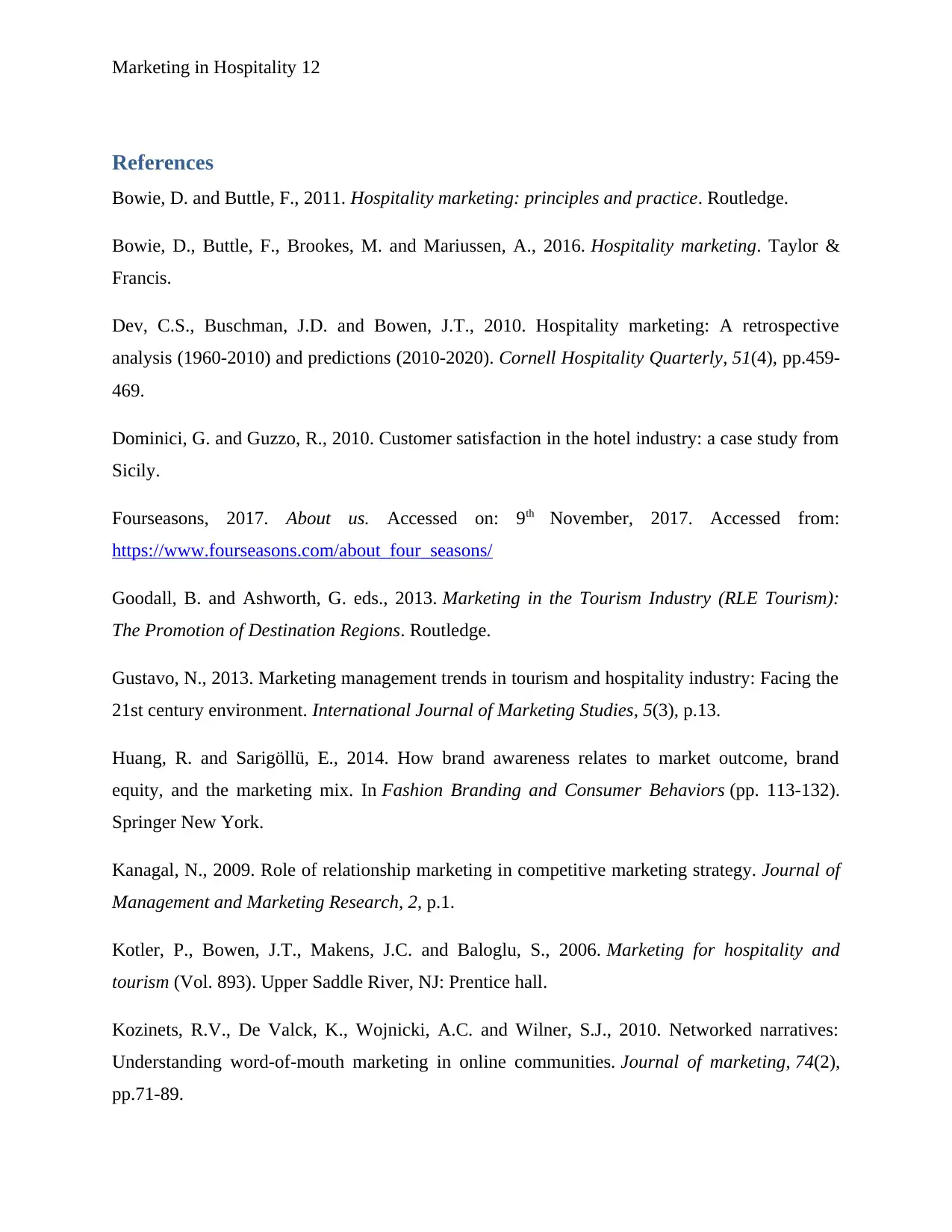
Marketing in Hospitality 12
References
Bowie, D. and Buttle, F., 2011. Hospitality marketing: principles and practice. Routledge.
Bowie, D., Buttle, F., Brookes, M. and Mariussen, A., 2016. Hospitality marketing. Taylor &
Francis.
Dev, C.S., Buschman, J.D. and Bowen, J.T., 2010. Hospitality marketing: A retrospective
analysis (1960-2010) and predictions (2010-2020). Cornell Hospitality Quarterly, 51(4), pp.459-
469.
Dominici, G. and Guzzo, R., 2010. Customer satisfaction in the hotel industry: a case study from
Sicily.
Fourseasons, 2017. About us. Accessed on: 9th November, 2017. Accessed from:
https://www.fourseasons.com/about_four_seasons/
Goodall, B. and Ashworth, G. eds., 2013. Marketing in the Tourism Industry (RLE Tourism):
The Promotion of Destination Regions. Routledge.
Gustavo, N., 2013. Marketing management trends in tourism and hospitality industry: Facing the
21st century environment. International Journal of Marketing Studies, 5(3), p.13.
Huang, R. and Sarigöllü, E., 2014. How brand awareness relates to market outcome, brand
equity, and the marketing mix. In Fashion Branding and Consumer Behaviors (pp. 113-132).
Springer New York.
Kanagal, N., 2009. Role of relationship marketing in competitive marketing strategy. Journal of
Management and Marketing Research, 2, p.1.
Kotler, P., Bowen, J.T., Makens, J.C. and Baloglu, S., 2006. Marketing for hospitality and
tourism (Vol. 893). Upper Saddle River, NJ: Prentice hall.
Kozinets, R.V., De Valck, K., Wojnicki, A.C. and Wilner, S.J., 2010. Networked narratives:
Understanding word-of-mouth marketing in online communities. Journal of marketing, 74(2),
pp.71-89.
References
Bowie, D. and Buttle, F., 2011. Hospitality marketing: principles and practice. Routledge.
Bowie, D., Buttle, F., Brookes, M. and Mariussen, A., 2016. Hospitality marketing. Taylor &
Francis.
Dev, C.S., Buschman, J.D. and Bowen, J.T., 2010. Hospitality marketing: A retrospective
analysis (1960-2010) and predictions (2010-2020). Cornell Hospitality Quarterly, 51(4), pp.459-
469.
Dominici, G. and Guzzo, R., 2010. Customer satisfaction in the hotel industry: a case study from
Sicily.
Fourseasons, 2017. About us. Accessed on: 9th November, 2017. Accessed from:
https://www.fourseasons.com/about_four_seasons/
Goodall, B. and Ashworth, G. eds., 2013. Marketing in the Tourism Industry (RLE Tourism):
The Promotion of Destination Regions. Routledge.
Gustavo, N., 2013. Marketing management trends in tourism and hospitality industry: Facing the
21st century environment. International Journal of Marketing Studies, 5(3), p.13.
Huang, R. and Sarigöllü, E., 2014. How brand awareness relates to market outcome, brand
equity, and the marketing mix. In Fashion Branding and Consumer Behaviors (pp. 113-132).
Springer New York.
Kanagal, N., 2009. Role of relationship marketing in competitive marketing strategy. Journal of
Management and Marketing Research, 2, p.1.
Kotler, P., Bowen, J.T., Makens, J.C. and Baloglu, S., 2006. Marketing for hospitality and
tourism (Vol. 893). Upper Saddle River, NJ: Prentice hall.
Kozinets, R.V., De Valck, K., Wojnicki, A.C. and Wilner, S.J., 2010. Networked narratives:
Understanding word-of-mouth marketing in online communities. Journal of marketing, 74(2),
pp.71-89.
⊘ This is a preview!⊘
Do you want full access?
Subscribe today to unlock all pages.

Trusted by 1+ million students worldwide
1 out of 14
Related Documents
Your All-in-One AI-Powered Toolkit for Academic Success.
+13062052269
info@desklib.com
Available 24*7 on WhatsApp / Email
![[object Object]](/_next/static/media/star-bottom.7253800d.svg)
Unlock your academic potential
Copyright © 2020–2025 A2Z Services. All Rights Reserved. Developed and managed by ZUCOL.





